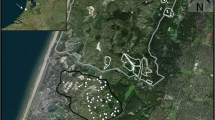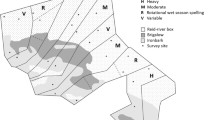Summary
Studies were conducted during the 1979 growing season to examine how North American bison (Bison bison) use prairie dog (Cynomys ludovicianus) colonies in Wind Cave National Park, South Dakota. Objectives included (1) determining whether bison selected for prairie dog towns parkwide; (2) characterizing in greater detail bison use patterns of a 36-ha colony in Pringle Valley as a function of time since prairie dog colonization; and (3) relating these bison use patterns to measured changes in structure and nutritional value of vegetation on and off the dog town.
During midsummer, prairie dog towns were one of the most frequently used habitats by bison parkwide. Day-long observations at Pringle Valley revealed that bison exerted strong selection (nearly 90% of all habitat use and feeding time) for the dog town, which occupied only 39% of the valley. While there, they partitioned their use of the colony by grazing in moderately affected areas (occupied <8 years by prairie dogs) and by resting in the oldest area (>26 years occupation).
Prairie dogs facilitate bison habitat selection for a shortgrass successional stage in this mixed-grass community by causing a broad array of compositional, structural, and nutritional changes in the vegetation.
Similar content being viewed by others
References
Allan PF, Osborn B (1954) Tallgrass defeats prairie dogs. Soil Conserv 20:103–105, 113
Arnold GW (1962) Factors within plant associations affecting the behavior and performance of grazing animals. In: Crisp PJ (ed) Grazing in Terrestrial and Marine Environments. Oxford, pp 133–154
Bell RHV (1971) A grazing ecosystem in the Serengeti. Sci Am 224(1):86–93
Bonham CD, Lerwick A (1976) Vegetation changes induced by prairie dogs on shortgrass range. J Range Manage 29:221–225
Caughley G (1976) The elephant problem: An alternative hypothesis. E Afri Wildl J 14:265–284
Cole LC (1949) The measurement of interspecific association. Ecology 30:411–424
Coppock DL (1981) Impacts of black-tailed prairie dogs on vegetation in Wind Cave National Park. M.S. Thesis, Colorado State Univ., Fort Collins. 86 pp
Coppock DL, Detling JK, Dyer MI (1980) Interactions among bison, prairie dogs and vegetation in Wind Cave National Park. Unpubl Final Report to National Park Service, Wind Cave National Park, South Dakota, 195 pp
Coppock DL, Detling JK, Ellis JE, Dyer MI (1983) Plant-herbivore interactions in a North American mixed-grass prairie. I. Effects of black-tailed prairie dogs on intraseasonal aboveground plant biomass and nutrient dynamics and plant species diversity. Oecologia (Berl) 56:1–9
Croze H (1974) The Seronera bull problem. Part 2. The trees. E Afri Wildl J 12:29–48
Dalsted KJ, Sather-Blair S, Worcester BK, Klukas R (1981) Application of remote sensing to prairie dog management. J Range Manage 34:218–223
Gwynne MD, Bell RHV (1968) Selection of vegetation components by grazing ungulates in the Serengeti National Park. Nature (London) 220:390–393
Hansen RM, Gold IK (1977) Blacktail prairie dogs, desert cottontails, and cattle trophic relations on shortgrass range. J Range Manage 30:210–213
Hobbs NT, Baker DL, Ellis JE, Swift DM (1981) Composition and quality of elk winter diets in Colorado. J Wildl Manage 45:156–171
Keith EO, Ellis JE, Phillips RW, Dyer MI, Ward GM (1981) Some aspects of urea metabolism in North American bison. Acta Theriol 26:257–268
King JA (1955) Social behavior, social organization, and population dynamics in a black-tailed prairie dog town in the Black Hills of South Dakota. Contrib from the Lab Vert Biol No 67 Univ Mich Ann Arbor. 123 pp
Koford CB (1958) Prairie dogs, whitefaces, and blue grama. Wildl Monogr No 3. 78 pp
Larson F (1940) The role of the bison in maintaining the shortgrass plains. Ecology 21(2):113–121
Leuthold W (1977) Changes in tree populations of Tsavo East National Park, Kenya. E Afri Wildl J 15:61–69
McHugh T (1958) Social behavior of the American buffalo (Bison bison bison). Zoologica 43(1):1–40
McNaughton SJ (1976) Serengeti migratory wildebeest: Facilitation of energy flow by grazing. Science 191:92–94
Osborn B, Allan PF (1949) Vegetation of an abandoned prairie-dog town in tallgrass prairie. Ecology 30:322–332
Peden DG, Van Dyne GM, Rice RW, Hansen RM (1974) The trophic ecology of Bison bison L. on shortgrass plains. J Appl Ecol 11:489–498
Popp JK (1981) Range ecology of bison on mixed-grass prairie at Wind Cave National Park. M.S. Thesis, Iowa State University, Ames. 59 pp
Schwartz CC, Ellis JE (1981) Feeding ecology and niche separation in some native and domestic ungulates on the shortgrass prairie. J Appl Ecol 18:343–353
Shult MJ (1972) American bison behavior patterns at Wind Cave National Park. Ph.D. Diss., Iowa State Univ., Ames. 178 pp
Sinclair ARE (1977) The African buffalo. A study of resource limitation of populations. Univ. Chicago Press, Chicago. 355 pp
Steel R, Torrie J (1980) Principles and procedures of statistics; A biometrical approach. 2nd ed. McGraw Hill Co., New York. 633 pp
Swift DM, Ellis JE, Hobbs NT (1980) Nitrogen and energy requirements of North American cervids in winter — a simulation study. In: Reimers E, Gaare E, Skjenneberg S (eds) Proc 2nd International Reindeer-Caribou Symposium, Røros, Norway, pp 244–251
Vesey-Fitzgerald DF (1960) Grazing succession among East African game animals. J Mammal 41(2):161–172
Vesey-Fitzgerald DF (1974) Utilization of grazing resources by buffaloes in the Arusha National Park, Tanzania. E Afri Wildl J 12:107–134
Author information
Authors and Affiliations
Rights and permissions
About this article
Cite this article
Coppock, D.L., Ellis, J.E., Detling, J.K. et al. Plant-herbivore interactions in a North American mixed-grass prairie. Oecologia 56, 10–15 (1983). https://doi.org/10.1007/BF00378211
Received:
Issue Date:
DOI: https://doi.org/10.1007/BF00378211




